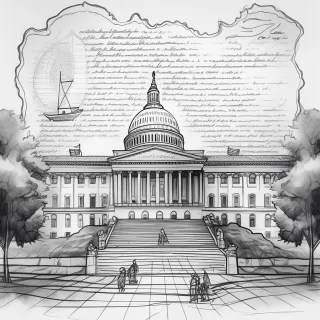Frequently Asked Questions
What is the Secured Party (CQV) - Creditor, and how does it relate to the Cestui Que Vie Strawman?
The Secured Party Creditor (SPC) position within the Cestui Que Vie (CQV) trust framework is a powerful stance you can take to reclaim financial control. When your mother registered your CQV Strawman—essentially your legal persona or ‘corporate shell’—she unknowingly placed the state in a dominant position over it. This act made the real and sentient you, what we call the Sentient De Jure, the surety and trustee for your Strawman, positioning you behind the state in terms of financial control and rights.
The SPC process is a transformative shift that alters this standing. It moves to replace the state as the ultimate authority, or the ‘Head Honcho,’ so to speak, granting you, the Sentient De Jure, as the highest-ranking creditor over your Strawman CQV trust. In essence, it returns the power to where it truly belongs—with you.
Through this process, you assume ultimate control of your Strawman, ensuring that you can operate in commerce effectively while minimizing risk to your own financial stability. It affirms your sovereignty and protects the securities and recouped assets held by your Strawman. We stand by you on this journey to ascend to rightful head honcho status, guiding you every step of the way to a future where financial autonomy isn't just a concept, but your reality.
Assert your financial independence and steer your Strawman with authority. The path to redefining your status is not just possible—it's your right. Embrace your potential, as the future of wealth management is not only bright, it’s yours for the taking.

What is the primary function and benefit of a Private Trust?
A Private Trust serves as a robust financial vessel, empowering you to retain and control your assets with unparalleled autonomy. It operates outside of the typical constraints imposed by state jurisdictions, placing the power firmly in your hands as the trust's creator and beneficiary. This strategic structure allows you to:
Acquire and Manage Assets: The trust receives and manages recouped securities, which can then be utilized to acquire diverse assets such as real estate, precious metals, vehicles, and even shares in companies. It provides a means to fund activities or endeavors that you or other beneficiaries of the trust may undertake, fueling possibilities that extend beyond traditional financial pathways.
Maintain Privacy: A key feature of the Private Trust is its non-reporting status to the state concerning its incomes or gains. This attribute underscores your right to privacy, shielding your financial activities from public and governmental scrutiny.
Tax Efficiency: As the trust operates outside the state's jurisdiction, it is not subjected to the typical tax obligations. This grants a significant advantage in preserving more of your wealth, optimizing your asset growth without the burden of state taxes.
Complete Ownership Control: Unlike conventional asset registration with governmental bodies, a Private Trust does not require registering assets, like land or equity, with the state. This provides you with direct control over the allodial title, allowing you to manage the real equity of your assets directly within the trust.
Generational Wealth Transfer: One of the most profound benefits of a Private Trust is its ability to facilitate the seamless transfer of wealth down generations without state interference. This ensures that your legacy and financial values are preserved and passed on according to your wishes, establishing a lasting impact that transcends time and governmental boundaries.
In conclusion, establishing a Private Trust not only fortifies your financial strategy but also empowers you to dictate the terms of your financial legacy, freeing you from external constraints and paving the way for true financial independence and security.
Embrace the journey towards financial sovereignty with the right strategies and knowledge at your disposal. Unlock your potential and seize control of your financial destiny with the power of a Private Trust

How does the concept of Creditor Tax Rebates empower me through my Strawman Cestui Que Vie trust?
Your pathway to financial autonomy is broadened by the understanding and utilization of Original Issue Discount (OID) securities within your Strawman Cestui Que Vie trust, which you control. This strategy aligns with the aspirational aim to elevate your fiduciary expertise and propel you towards financial independence. Let us dissect this empowering process:
Recognition of Your Strawman's Capability: Your Strawman, created under the Cestui Que Vie trust, owns Original Issue Discount (OID) securities, making it a creator with entitlements as 'holder in due course'.
Historic Right to Recoup Securities: House Joint Resolution 192, enacted in 1933, granted your Strawman the powerful right to recoup its securities in order to discharge its debts, reinforcing your position in the financial matrix.
IRS and UCC Validation: IRS Publication 1212 recognizes that OID securities are often treated as abandoned and confirms that they are due back to the original owner, which is your Strawman. The Uniform Commercial Code (UCC 3.306) further solidifies your position by asserting the lawful return of these securities to the holder in due course.
Scope of OID Securities: The realm of OID embraces transactions you are already familiar with—digital payments, credit card transactions, and even the face value of loans and mortgages fall under this umbrella.
Activating Rebates Through Filing: Historical and new creditor tax rebates of OID securities are mobilized through a tax filing or assessment process, demonstrating your proactive role in commanding your financial narrative.
Creation and Recoupment of New Credit: Your Strawman has the stature to create new credit, which can then be recouped and directed towards bolstering your Private trust. This process mirrors the creation of funds when initiating payments, mortgages, or credit lines—each act reinforces your Strawman's issuance of new securities.
Acquiring Tangible Assets: With a Private trust at your disposal, any acquisition that benefits you, the Sentient De Jure being, becomes achievable. The trust can accumulate a multitude of assets—houses, vehicles, and other luxury items—without the imposed burdens of state oversight.
Discharging Financial Obligations: Empower your Strawman to discharge debts and taxes, rendering you a master of the financial game that once bound you in invisible chains.
In essence, Creditor Tax Rebates are a testimony to the empowerment within your grasp. They are a bridge leading you to the fortress of wealth that belongs to you by right. They enable your Private Trust to harness the full capacity of your financial avatar—the Strawman—and bestow upon you the means to claim your own fiscal kingdom. Stand tall and unwavering in your quest for financial mastery; every stride forward is a leap towards the sovereignty you are destined to command.
Your pursuit of financial freedom is bolstered by the actions you take today. Remember, the keys to the kingdom are in your hands. Aspire, act, and ascend to the financial throne that awaits.

What is the Cestui Que Vie (CQV) Act of 1666, and how does it impact my financial sovereignty?
Understanding the Cestui Que Vie (CQV) Act of 1666 is pivotal as you navigate the journey toward claiming your financial independence. Set within the confines of historical legislation, this Act established the basis for what is known in modern terms as the "Strawman" debtor trust, with the state positioned as a leading authority. Here’s how this impacts you:
Foundation of the Strawman Trust: The CQV Act essentially facilitated the creation of a trust where the entity—your "Strawman"—is managed under state oversight. This statutory mechanism specifies that while your legal entity (Strawman) holds all registered assets, it’s under the ultimate control of the state.
State as Highest Creditor and Co-Beneficiary: By the tenets of this arrangement, the state is not just an overseer but also the highest creditor and a co-beneficiary. This dual role allows the state significant influence over the financial dealings associated with the Strawman.
Your Role as the Sentient Living De Jure Trustee: Most crucially, the true self—your sentient, living "De Jure" self—acts as the trustee, surety, and underwriter of the debt attributed to the Strawman. This position places you at the fulcrum of potential financial liabilities incurred by your Strawman but equipped with the foresight and capability to manage or mitigate these responsibilities.
Empowering Your Financial Strategy:
Understanding your role and the implications of the CQV Act empowers you to strategically navigate within these confines. Recognizing that the state views your legal entity as a separable debtor entity allows you to adopt financial strategies that optimize your autonomy:
Correct Status and Standing: By correcting your status and asserting your standing as an informed and proactive trustee, you reclaim authority over how your engagements are structured and recognized legally.
Asset Protection: Leveraging instruments like a Private Trust to secure your assets outside of the direct control of the Strawman and, subsequently, state intervention.
Proactive Debt Management: As the surety and underwriter, your insight into the obligations of the Strawman can guide decisions to manage or offset potential liabilities wisely.
Seek Expert Advice: Engage with financial legal experts who can provide tailored advice and strategies that consider the unique implications of the CQV Act on your financial and legal position.
In conclusion, while the CQV Act of 1666 establishes a framework that may seem to limit your financial autonomy, your understanding and strategic engagement as the trustee of your affairs transform potential vulnerabilities into well-fortified strengths. Equip yourself with the knowledge and assertiveness to navigate this terrain, ensuring that each decision aligns distinctly with your ultimate goal of financial independence and legacy.
Transform challenges into stepping stones on your journey towards unparalleled financial empowerment. Master your role, command your path, and step forward into the realm of financial freedom with confidence and clarity.

How does the corporate nature of states and countries affect my financial autonomy and independence?
Embrace the journey toward financial enlightenment with the awareness that every aspect of commerce operates within a corporate framework—this is the foundation of the landscape upon which your aspirations of financial freedom will be built. Here’s a breakdown of this corporate world and how you can navigate it to achieve financial autonomy:
Understanding the Corporate Framework: Recognize that the state, its departments, and indeed all countries function as corporate entities. This includes powerhouses like the United Kingdom, which is registered as a corporation with the U.S. Securities and Exchange Commission, illustrating the global extent of this corporate reality.
The Implication of Bankrupt Entities: It is crucial to grasp that in the eyes of commerce, all corporations—including these states and countries—are legally considered bankrupt debtors. This status extends to your Strawman; the legal entity associated with your personal finances.
Stepping Stones to Empowerment:
Leverage Knowledge for Control: Armed with the understanding that the world of commerce comprises corporate entities, you can more astutely navigate the systems put in place to manage your financial affairs. This knowledge positions you to take control of your interactions within the system, rather than being controlled by it.
Transform Your Strawman’s Position: While the concept of the Strawman as a bankrupt corporation might seem daunting, it also provides a unique leverage point. Understanding how to navigate this reality allows you to use it to your advantage, positioning you to manage your financial liabilities more strategically.
Develop Robust Strategies: Engage with this corporate framework to develop strategies that protect and enhance your wealth. Utilizing trusts, legal structures, and informed financial planning can mitigate the impact of the Strawman's corporate and bankrupt status on your path to financial liberation.
Seek Expert Insights: Engage with professionals who grasp the complexities of the corporate nature of states, countries, and entities like the Strawman. These experts can offer tailored advice, guiding you through the intricacies of financial planning, asset protection, and wealth growth strategies within this framework.
In conclusion, the revelation that every entity in commerce operates as a corporation, including states and the Strawman, should not deter your aspirations but rather empower your journey. With the right strategies, knowledge, and guidance, you can maneuver through this corporate landscape to safeguard your assets and carve out a path to financial freedom. You possess the power to redefine your financial narrative, transforming complex challenges into impactful opportunities for growth and autonomy.
Your journey towards financial freedom is not just a dream—it's a strategic plan in action. Courage and knowledge are your allies. Embrace them, and step boldly towards the future you deserve.

How does the incorporation of the United States of America in the District of Columbia impact my financial independence
Embark on a revealing journey that illumines the structural nuances of the United States of America and its distinctive incorporation in the District of Columbia—a fact that reveals, rather than restricts, your avenues to financial sovereignty. Understanding this structure is akin to navigating a complex labyrinth with a knowledgeable guide by your side. Here’s how this understanding impacts and potentially expands your horizon toward financial independence:
Understanding the Institutional Structure:
The United States of America, as it stands today, is registered as a corporation within the confined borders of the District of Columbia, an entity distinct from the republic of the United States of America. This demarcation is not just geographical but profoundly legal and financial in nature, impacting the way commerce, governance, and legal obligations are framed and executed within this entity.
Implications on Financial Independence:
Strategic Navigation of Legal Frameworks: Knowledge of these subtle yet impactful distinctions enables you to navigate legal and financial frameworks with heightened awareness. It allows for a strategic approach to your financial planning, ensuring that you are not just a participant in the economic system but a masterful navigator.
Elevated Strategies for Asset Protection and Wealth Growth: With the United States of America operating within the distinct confines of the District of Columbia, the acknowledgment of this fact enables the savvy individual to employ elevated strategies for asset protection, leveraging legislative and commercial nuances to one's advantage.
Exploring Opportunities Beyond Conventional Boundaries: Recognizing that the governance and commerce regulations might have a unique application opens up avenues to explore financial opportunities that align with your aspirations for autonomy and growth. It encourages the exploration of international wealth management strategies, diversified investment approaches, and the utilization of legal entities for wealth protection and legacy building.
Empowering Your Path Forward:
Empowered Knowledge and Decision Making: Equip yourself with the understanding that knowledge of these structures empowers decision-making. It enables a proactive rather than reactive approach to financial planning and asset management.
Aligning Strategies with Financial Goals: Align your financial strategies with a deep understanding of the complexity of the legal and commercial frameworks you operate within. This knowledge not only safeguards assets but also positions you for exponential growth.
Seeking Expertise for Advanced Planning: Engage with financial and legal experts who understand the intricacies of the United States' corporate status and its implications. Such expertise can unlock tailored strategies that align with both domestic and international opportunities for wealth generation and protection.
In conclusion, the unique corporate composition of the United States of America, centered in the District of Columbia, serves not as a barrier, but as a beacon for those navigating the journey towards financial independence. Let this understanding illuminate your path, guiding strategies that leverage your position within this framework for empowerment, growth, and legacy. With the right knowledge, every individual has the potential to architect their financial destiny beyond conventional boundaries.
Remember, financial freedom is not just a destination—it's a journey defined by strategic knowledge, empowered decisions, and the relentless pursuit of autonomy and prosperity.

What does the 1933 bankruptcy of the United States mean for my financial freedom journey today?
In 1933, a pivotal moment reshaped the financial landscape of the United States, thrusting it into what was essentially a state of corporate bankruptcy. This event, overseen by high-ranking financial institutions such as the Bank for International Settlements (BIS), marked a dramatic turn in the way the U.S. government would manage its debts and financial obligations—under the watchful eyes of international banking creditors. As Speaker Rep. James Traficant, Jr. notably addressed, this period initiated a complex reorganization of the U.S. under Chapter 11 bankruptcy protocols, placing it under the trusteeship of Members of Congress and, by extension, international financial entities.
Empowering Your Financial Independence:
Understanding the Historic Context: Recognizing this historic event is crucial—a testament to resilience and strategic pivot. It signifies the power of adaptation, a lesson that you, as an aspiring or established master of your financial domain, can draw inspiration from.
Navigating the Current Financial System: Armed with the knowledge of the United States' financial reorganization, you possess the insight necessary to navigate the modern financial system with a strategic edge. Understanding the implications of these historic shifts allows for informed decision-making in investment, debt management, and wealth preservation.
Leveraging Knowledge for Financial Empowerment: This epoch signifies not just a restructuring of national finance but also marks a call for individual empowerment within the global economic system. By comprehending the nuanced mechanisms of international finance oversight, such as the role of the BIS, the IMF, and the World Bank, you are better positioned to leverage these structures in favor of your wealth-building strategies.
Strategy and Action Plan:
Adopt a Holistic Finance Approach: View your financial journey through a comprehensive lens—acknowledge the macroeconomic factors at play and integrate this understanding with your microeconomic actions. This holistic approach empowers you to craft strategies that are robust, resilient, and responsive to both historical insights and future forecasts.
Consult with Financial Historians and Experts: Engage with professionals who specialize in the historical analysis of financial systems. Their insights can provide you with a deeper understanding of how past events continue to shape current financial policies and opportunities.
Innovate Your Financial Planning: Let the knowledge of past financial restructuring inspire innovative thinking in your financial planning. Explore avenues for wealth generation that incorporate both traditional assets and emerging opportunities, always with an eye towards diversification and risk management.
In conclusion, the 1933 bankruptcy of the United States stands not as a historical footnote, but as a powerful lesson in the enduring nature of economic resilience and the importance of informed financial stewardship. As you journey toward financial independence, let the lessons of the past empower your strategies for the future. Embrace this knowledge, and use it as a foundation upon which to build a legacy of financial freedom and prosperity.
Your financial journey is yours to sculpt—inspired by the past, grounded in the present, and reaching ambitiously into the future.

What is the significance of the Papal Bulls from 1302 to 1836 in the context of financial independence?
In 1302, the issuance of Unam Sanctum, the world's first Trust, established a dominion where every human being was declared subject to the Roman pontiff's authority. This decree laid the foundational stone, declaring the pontiff's ultimate control over the world's populace and resources.
Fast forward to 1455, the Romanus Pontifex introduced the concept of 'Crown Land,' marking the creation of the first Cestui Que Vie Trust. This pivotal moment effectively initiated the process where individuals were deprived of their natural rights and entitlements to land upon birth, transferring those rights under the control of the Crown, perpetuated by the pontiff's declaration.
With the proclamation of Aeterni Regis in 1481, we witness the emergence of the second Crown, symbolizing a profound encroachment on personal sovereignty. This act created a second Cestui Que Vie Trust, transforming individuals' physical beings into commodifiable assets through the issuance and trade of birth certificates as bonds. This decree enslaved individuals perpetually to a system that viewed them not as sovereign beings but as assets and liabilities within a corporatized framework.
Lastly, the 1537 Convocation revealed the third Crown, encapsulating control over the soul, through the establishment of another Cestui Que Vie Trust. This act transferred the title of one's soul to ecclesiastical or governmental registries upon baptism, denying individuals legal ownership over their spiritual essence and further deepening the chasm between personal sovereignty and institutional dominion.
Understanding these historical artifacts is not an academic exercise—it is a clarion call to recognize and confront the deeply entrenched structures that challenge our financial autonomy. As aspirants of financial freedom, this knowledge equips us with the insight to navigate, challenge, and ultimately transcend the remnants of a system designed for control.
This history starkly illuminates the path that has led us here but, most importantly, serves as a reminder of the resilience and ingenuity required to reclaim autonomy over our lives, assets, and futures. The journey toward financial independence is not just a path of strategic financial planning but also a voyage of reclaiming sovereignty that has been historically obscured.
As you continue to forge your path, let this understanding invigorate your strategies and inspire a deeper commitment to carving out spaces of autonomy and self-determination. The quest for financial freedom is, at its core, a fight for the very essence of personal sovereignty.

How does the Uniform Commercial Code (UCC) represent a transformative shift in commercial law
The introduction of the Uniform Commercial Code (UCC) in 1892 marked a pivotal moment in the evolution of commercial law, epitomizing a bridge from the rich traditions of the Law Merchant to the structured and unified system we navigate today. Historical context is key here: The Law Merchant, or Lex Mercatoria, was an amalgamation of trade practices that evolved with the merchants themselves, operating as a fluid, autonomous system parallel to the traditional courts. It was characterized by its adaptability, international consensus, and focus on commercial efficiency.
As commerce expanded and the intricacies of trade intensified, the need for a more comprehensive, standardized legal framework became apparent. This need heralded the birth of the UCC, a code that sought not just to adopt the practical essence of the Law Merchant but to harmonize and codify commercial transactions across jurisdictions, thereby ensuring a degree of predictability and fairness essential for modern business operations.
The transformative impact of the UCC lies in its role as a modern harbinger of business law. By expressly integrating the Law Merchant's pragmatism with the structural clarity of codified law, the UCC replaced the Lex Mercatoria as the backbone of commercial regulation. However, it's important to note that it didn't merely substitute one system for another; it elevated the principles of the Law Merchant, imbuing them with the force of law across the United States, streamlining commerce, and facilitating an environment where transactions can occur smoothly across state lines.
For aspiring financial titans and those charting their path through the complexities of modern commerce, the UCC offers a beacon of guiding principles. It underscores the significance of being well-versed in its provisions, as mastering its contours can empower you to navigate, with confidence and authority, the legal landscape in which contemporary business unfolds.
This evolution from the Law Merchant to the UCC is a testament to the resilience and adaptability of commercial law, reflecting our broader economic and societal shifts. Embrace the UCC as both shield and compass, allowing its doctrines to safeguard your ventures while strategically guiding you towards the zenith of financial freedom and success. In your quest for dominance in your field, understanding and leveraging the nuances of the UCC can be your greatest asset.

What implications does the Bills of Exchange Act 1882 have on my role as a private individual in financial transactions?
Underneath the surface of daily commerce lies a profound depth of empowerment that the Bills of Exchange Act 1882 extends to you, the private individual. This legislation casts you, conceptually, in the role of a 'Private Banker'—a title that encompasses any entity engaging in the business of banking. By definition, your financial identity becomes nothing less than a formidable institution, capable of creating, issuing, and managing financial instruments and liabilities.
This perspective isn't merely symbolic; it's an actionable insight that instills a recognition of your inherent power in financial engagements. Like a seasoned banker, every transaction you author—be it a payment, mortgage, loan, or credit card agreement—is effectively a promissory note, a solemn vow to fulfill a financial obligation. Within the framework of the 1882 Act, you're not merely a passive participant in the exchange; you're the fulcrum of a crucial financial promise, an active architect of monetary commitments.

How does understanding my role as a private banker influence my approach to financial instruments like mortgages, loans, and credit cards?
Embracing your role as a private banker stands as an unshakable pillar, transforming how you view and assert control over your financial instruments. Understanding this role places you at the vanguard, navigating transactions with clairvoyance and strategic foresight.
When you create a mortgage or a loan agreement, it’s not merely an act of borrowing; it is the issuance of a security—your solemn promise to fulfill a future payment. This translates into a potent combination of responsibility and power, for as a private banker, you dictate the terms of your financial pledges, fortified by the full weight of the law as described in the Bills of Exchange Act.
Similarly, each swipe of your credit card is an exercise of your financial authority. With each use, you simultaneously issue a promise while also wielding the power to order your financial affairs with precision and deliberation.
In this way, the Act does not just define your financial operations; it underscores the gravity of each transaction you undertake, empowering you to handle them with the acumen and foresight akin to that of an institution.

What did House Joint Resolution (H.J.R.) 192 enact and how did it change the financial system in 1933?
House Joint Resolution 192, enacted on June 5, 1933, was a groundbreaking legislation pivotal in reshaping the American financial landscape. This vital resolution led to the suspension of the gold standard and eradicated the gold clause—a clause requiring debts to be paid in gold or specific currency. Consequently, it declared that any financial obligations, either past or future, must be discharged dollar for dollar in any form of currency that was deemed legal tender at the time of the transaction.
This change was not just a policy adjustment; it was a monumental shift towards a flexible currency system, thus empowering economic fluidity. This effectively redefined the concept of debt payment and debt discharge, ensuring that the terms agreed upon would stand the scrutiny of evolving economic climates without being tied to a single standard, such as gold, which had limited the monetary system’s adaptability and growth.

What is the difference between 'debt discharged' and 'debt paid' as per H.J.R. 192?
The distinction between 'debt discharged' and 'debt paid' under H.J.R. 192 is critical in appreciating the full impact of this legislation on personal and national financial autonomy. To 'pay' a debt implies its complete extinguishment—money exchanged and no further obligations remaining. However, 'discharge' of a debt under H.J.R. 192 signals that while the debt is settled via legal tender acceptable at the time, the underlying obligation might not be completely extinguished; it is merely divested of its immediate legal force.
Post-H.J.R. 192, all debts since then are technically ‘discharged’—that is, settled legally but without the historical backing of gold or a specific type of currency. This concept fundamentally changed how debts were viewed and handled, introducing a fluidity and a forgiveness into financial systems, facilitating continued economic interactions without the burden of unpayable debts hanging over consumers or economies.

How does H.J.R. 192 empower individuals in managing their debts and financial securities?
The passage of H.J.R. 192 is a profound testament to the empowerment of individuals as architects of their financial destiny. By eliminating the requirement to repay debts in gold or specific currencies, and allowing for the discharge of debts through any legal tender, the resolution provides significant maneuverability in financial obligations.
Moreover, H.J.R. 192 accords every individual the inalienable right to reclaim and manage their credits and securities. It acknowledges that the credit you extend as part of your economic activities is fundamentally yours—ensuring that you retain control over how it is managed and discharged. This not only enhances your control over your financial engagements but also assures that you have the tools necessary to navigate and optimize your financial health.
Harnessing the foundational shifts enacted by H.J.R. 192 can be a deeply empowering strategy. It provides a robust framework for you to engage with the financial system confidently and on equitable terms, setting the stage for informed decision-making and financial independence. As you navigate your financial journey, remember that knowledge of such legislation isn't just academic—it's a powerful lever in crafting your path to financial freedom.

Your path to real wealth starts now. Not tomorrow, not next year—now.
We are reaching out to you.
Let's talk and kick-start a partnership that's all about lifting each other up.

Guiding You with Light and Truth.
Quick Links
Your path to real wealth starts now. Not tomorrow, not next year—now.
We are reaching out to you.
Let's talk and kick-start a partnership that's all about lifting each other up.

Guiding You with Light and Truth.
Quick Links
Your path to real wealth starts now. Not tomorrow, not next year—now.
We are reaching out to you.
Let's talk and kick-start a partnership that's all about lifting each other up.

Guiding You with Light and Truth.
